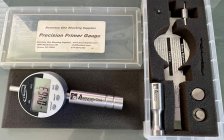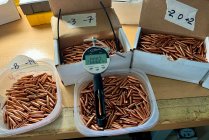Install the app
How to install the app on iOS
Follow along with the video below to see how to install our site as a web app on your home screen.
Note: This feature may not be available in some browsers.
You are using an out of date browser. It may not display this or other websites correctly.
You should upgrade or use an alternative browser.
You should upgrade or use an alternative browser.
Micrometer Seating dies
- Thread starter Pete Wass
- Start date
FeMan
Gold $$ Contributor
I can say that I am jealous! I often fight the CBTO spread and rarely have results that uniform.I use custom bullets, Micron seating dies and AMP press and there's hardly any variation B to O, recently loaded 200 rounds for a match and found two or three rounds where B to O was off by .001"
So if uniformity and precision is what you're looking for a quality components and tools are critical IMO
I would bet though that little if any of that success is due to the dies. I would guess it is attributable more to custom bullets with very consistent ogive, great brass prep, and a consistent hand on the press.
I'm guessing the set screws you mention refer to the Sinclair (LE Wilson) die since it does use a set screw to keep the seating stem in it's set position. Since I use their seating dies, I'm curious why you feel that set screw might, or will induce runout?and no set screws of any kind to introduce runout
Thank you.
Last edited:
Pete Wass
Gold $$ Contributor
What are you using to measure with?I use custom bullets, Micron seating dies and AMP press and there's hardly any variation B to O, recently loaded 200 rounds for a match and found two or three rounds where B to O was off by .001"
So if uniformity and precision is what you're looking for a quality components and tools are critical IMO
Pete Wass
Gold $$ Contributor
I thought it interesting in the interview Erik Cortina did with Jeff Pinehardt in which Pinehardt said he had never ben able to see any relevance to straight ammo vs not straight and thought it a waste of time being concerned about it.Years ago I did a test, comparing 6PPC loaded round straightness produced by a Hornady seater, and a Wilson. The cases had the same runout. The runout for the Hornady round was twice that of the Wilson. Admittedly this was the smallest possible sample, but I was familiar with what my usual results were for the Wilson. The most finely fitted seater that I own is one made by Don Nielson, it fits much more closely than any other, and is specific to a .262 neck 6PPC chamber. Since no micrometer is available for it, I learned to adjust it by the overall length of the stem and cap. Since then, for arbor press dies, that is my preferred method of adjustment.
I have the same thing along with their shoulder garage and bullet length gauge
muleystalker
Silver $$ Contributor
If you want a threaded seating die Short Action Customs make a very nice one, it comes with a Mitutoyo Dial on top and the die is modular within the parent case parameters. It comes with different size seating stems. So say in a die made for .480 cases you can do all BR .22,6mm,25,30. or all BRX and Dasher, 6.5x47 and all caliber sizes. all Creedmoor, Gt family, 308 family all off this one die. They are made very well. Mine have worked great. https://shortactioncustoms.com/product/the-seating-die/
muleystalker
Silver $$ Contributor
The seating stem in the Sinclair die is hand fit to the bore of the die and so tight I doubt the set screw could affect anything. Also you could leave the screw out.I'm guessing the set screws you mention refer to the Sinclair (LE Wilson) die since it does use a set screw to keep the seating stem in it's set position. Since I use their seating dies, I'm curious why you feel that set screw might, or will induce runout?
Thank you.
Steve Donlon
Gold $$ Contributor
I'll vote for the Redding Competition Seating Die. I have one for every caliber I reload, even the 45 acp.
Last edited:
Mostly depends on what you really want to accomplish, what your OCD level is, and whether you can shoot the measured/percieved difference, and what you are willing to spend. I'm content with mostly Forster, have Redding and RCBS too. Forster are pretty nice and easy to read, I like the bullet window on RCBS too. RCBS may have improved over the years, one I have is 1st version, about 35 yrs old, new one has a new head on it, may be easier to read. Not that I find any of them hard to read. Rseults seem to be about te same on them +/- about .001 is what I've been getting for the most part, occasional .002 or 3 here and there, I usually blame that on the brass. Consider the tooling these companies have these days, they have to have an operator screw up pretty bad. Not sure what you are really paying for with some of the higher priced stuff these days, and if whatever extra finishing they do is really worth the loot. Wind has way more influence.
Similar threads
- Replies
- 33
- Views
- 2,255
Upgrades & Donations
This Forum's expenses are primarily paid by member contributions. You can upgrade your Forum membership in seconds. Gold and Silver members get unlimited FREE classifieds for one year. Gold members can upload custom avatars.

Click Upgrade Membership Button ABOVE to get Gold or Silver Status.
You can also donate any amount, large or small, with the button below. Include your Forum Name in the PayPal Notes field.
To DONATE by CHECK, or make a recurring donation, CLICK HERE to learn how.

Click Upgrade Membership Button ABOVE to get Gold or Silver Status.
You can also donate any amount, large or small, with the button below. Include your Forum Name in the PayPal Notes field.
To DONATE by CHECK, or make a recurring donation, CLICK HERE to learn how.











